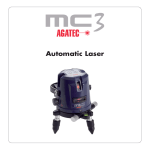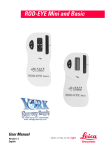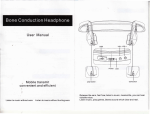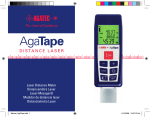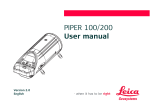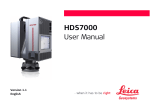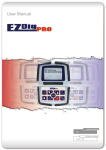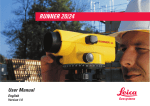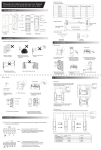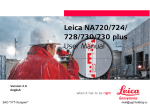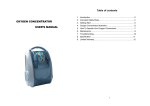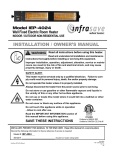Download manual
Transcript
Automatic Laser Table of contents 2 General description Case Control panel Laser receiver First steps Horizontal alignment Vertical alignment Plumb beam 3 Safety directions General Limits of Use Responsibilities Hazards of Use Laser Classification Accuracy control 8 Warranty 14 Technical data 15 EN Congratulations! On choosing this Agatec instrument. You will know, of course, that the name Agatec is synonymous with high quality, accurate measuring instruments. With the input from professional end users, we are able to produce cutting-edge, user-friendly equipment. Agatec MC8 An extremely accurate, professional mains-powered laser whose extra powerful laser diodes provide ultra-visible beams. Automatic levelling using electronically controlled motors. Electronic spirit levels guarantee superior stability and extremely precise levelling. General description Case 3 1. vertical laser exit 2. horizontal laser exit 1 3. rotating case 2 4. fine adjustment 5. feet 6. plumb beam 8 7. 5/8 threaded tripod adaptor fitting 8. Tripod adaptor 4 5 4 6 7 3 Control panel 9. 10. 11. 12. on-off switch vertical laser lines horizontal laser lines outdoor = manual receiver mode 11 10 9 12 Laser receiver (optional) 13. on-off switch 14. on-off audible signal 15. receive area 15 13 14 4 EN IMPORTANT! Before using the instrument, carefully read the instructions for use. Keep the instructions in a safe place for future reference if required. 1. Whether on or off, keep the instrument out of reach of children. 2. This equipment is a high quality precision instrument which must be handled with care. 3. Take care to avoid jolts and vibration. 4. Always replace the instrument in its carrying case after use. 5. Make sure that the carrying case and the instrument are dry; if not, condensation may occur inside the instrument. 6. Make sure that the windows are clean, and use only an appropriate cleansing product and soft cloth. 7. Always use the locking device during transportation. 8. Check the accuracy of the instrument regularly, especially at the start of important surveying operations. You are solely responsible for the accuracy of your work. 9. Do not use any optical instrument such as a magnifying glass to set the laser beam, and pay attention to reflective objects to avoid damage to the eye. 10. Locate the laser in such a way that it is not possible for any person to observe the laser beam, whether intentionally or otherwise. 11. Under no circumstances should the instrument be taken apart - this may result in exposure to powerful laser radiation. 12. The instrument should only be used for the projection of laser lines. 13. Do not use the instrument in wet conditions or near flammable materials. 14. Technical alterations or modifications to the instrument may be made without notice. 15. The manufacturer's responsibility shall in no case exceed the value of the costs of repair or replacement of the instrument 16. Respect the environment, and do NOT discard the instrument or batteries (including rechargeables) in the rubbish bin. Dispose of them at a recycling centre. 5 First steps • Remove any protective plastic film where applied. • Charge the rechargeable batteries using the battery charger. • The indicator lights come on when the charger is connected to the mains supply. These go out when the batteries have been charged. • NB: always use rechargeable batteries in the charger. • Open the battery compartment and insert the batteries observing the polarity indicated. • Then switch on the instrument; the power indicator remains continuously lit. If the batteries are nearly exhausted, the power indicator will flash. • Take care not to place the instrument at too great an angle (less than 4°). If the slope of the instrument should exceed 4°, the lasers will flash automatically or will go out. • Use the adjustable feet or place the support such that the level indicatoris continuously lit for 10 seconds, and the laser beams no longer flash. • NB: this instrument may also be used with a mains adaptor to operate directly from mains power. Make sure that the mains cable does not lie in the road (damage caused by a fall). Horizontal alignment • Once the instrument is within its levelling range, then the laser lines are automatically level. • The horizontal lines may be turned on or off using button "H". • If possible, it is recommended that the horizontal line should be placed at working height. This will improve the quality of your work. • NB: cross and line lasers can only be used on supports of adjustable height, such as tescopic and rod supports. • Before placing the instrument on a support, the support adaptor should be mounted on the instrument. Only use supports with a 5/8 screw thread. • Important: to a large extent, choice of support will determine how easy the instrument is to use. • If the workplace is very brightly lit, when working out of doors for example, it may be necessary to use the laser receiver. 6 EN Vertical alignment • Once the instrument is within its levelling range, the vertical laser lines may be turned on using button "V". These are mutually at 90°. • Owing to the automatic levelling, the laser lines are correctly level and are perpendicular to the horizontal laser line. • The rotatable case and fine adjustment may be used for positioning the vertical line. • The fine adjustment enables the laser beam to be located quickly and accurately onto your marker at large distances • Owing to the powerful laser diode and projection at an obtuse angle, the laser beam is visible behind the instrument and a laser cross appears on the ceiling. The lower the instrument is located, the nearer it is to the wall, and the longer the laser beam. E.g. for placing of walls. • If the workplace is very brightly lit, when working out of doors, for example, it may be necessary to use the laser receiver. Plumb beam • The plumb point is visible as soon as a vertical laser is turned on. • Use the plumb point as an aid in simpler positioning of the vertical laser beam under certain circumstances or for tracing perpendicular angles. • For example: if a parallel line needs to be projected onto the wall or onto the ceiling. Start by placing the instrument with its plumb point above the first marker; then rotate the vertical line as far as marker no. 2, using the fine adjustment for faster and simpler setting. • The plumb point is level with the laser cross vertical on the ceiling. This position is ideal for adjustment of squaring points or for tracing out on the walls. 7 Safety directions GENERAL Description The following directions should enable the person responsible for the product, and the person who actually uses the equipment, to anticipate and avoid operational hazards. The person responsible for the product must ensure that all users understand these directions and adhere to them. Adverse Use • Use of the product without instruction. • Use outside of the intended limits. • Disabling safety systems. • Removal of hazard notices. • Opening the product using tools, for example screw- driver, unless this is specifically permitted for certain functions. • Modification or conversion of the product. • Use after misappropriation. • Use of products with obviously recognizable damages or defects. • Use with accessories from other manufacturers without the prior explicit approval of Agatec. • Inadequate safeguards at the work site, for example when using on or near roads. • Deliberate dazzling of third parties. • Controlling of machines, moving objects or similar monitoring application without additional control and safety installations. WARNING Adverse use can lead to injury, malfunction and damage. It is the task of the person responsible for the equipment to inform the user about hazards and how to counteract them. The product is not to be operated until the user has been instructed on how to work with it. 8 EN LIMITS OF USE Environment Suitable for use in an atmosphere appropriate for permanent human habitation: not suitable for use in aggressive or explosive environments. DANGER Local safety authorities and safety experts must be contacted before working in hazardous areas, or in close proximity to electrical installations or similar situations by the person in charge of the product. RESPONSIBILITIES Manufacturer of the product Agatec SAS, 21, boulevard Littré, F-78600 Le Mesnil Le Roi, hereinafter referred to as Agatec, is responsible for supplying the product, including the user manual and original accessories, in a completely safe condition. Manufacturers of non Agatec accessories The manufacturers of non Agatec accessories for the product are responsible for developing, implementing and communicating safety concepts for their products, and are also responsible for the effective- ness of those safety concepts in combination with the Agatec product. Person in charge of the product The person in charge of the product has the following duties • To understand the safety instructions on the product and the instructions in the user manual. • To be familiar with local regulations relating to safety and accident prevention. • To inform Agatec immediately if the product and the application becomes unsafe. WARNING The person responsible for the product must ensure that it is used in accordance with the instructions. This person is also accountable for the training and the deployment of personnel who use the product and for the safety of the equipment in use. 9 HAZARDS OF USE WARNING The absence of instruction, or the inadequate imparting of instruction, can lead to incorrect or adverse use, and can give rise to accidents with far-reaching human, material, financial and environmental conse- quences. Precautions: All users must follow the safety directions given by the manufacturer and the directions of the person respon- sible for the product. CAUTION Watch out for erroneous measurement results if the product has been dropped or has been misused, modified, stored for long periods or transported. Precautions: Periodically carry out test measurements and perform the field adjustments indicated in the user manual, particularly after the product has been subjected to abnormal use and before and after important measurements. WARNING If the product is used with accessories, for example masts, staffs, poles, you may increase the risk of being struck by lightning. Precautions: Do not use the product in a thunderstorm. WARNING Inadequate securing of the working site can lead to dangerous situations, for example in traffic, on building sites, and at industrial installations. Precautions: Always ensure that the working site is adequately secured. Adhere to the regulations governing safety and accident prevention and road traffic. CAUTION If the accessories used with the product are not properly secured and the product is subjected to mechanical shock, for example blows or falling, the product may be damaged or people may sustain injury. 10 EN Precautions: When setting-up the product, make sure that the accessories are correctly adapted, fitted, secured, and locked in position. Avoid subjecting the product to mechanical stress. CAUTION During the transport, shipping or disposal of batteries it is possible for inappropriate mechanical influences to constitute a fire hazard. Precautions: Before shipping the product or disposing of it, discharge the batteries by running the product until they are flat. When transporting or shipping batteries, the person in charge of the product must ensure that the applicable national and international rules and regulations are observed. Before transportation or shipping contact your local passenger or freight transport company. WARNING High mechanical stress, high ambient tempera- tures or immersion into fluids can cause leackage, fire or explosions of the batteries. Precautions: Protect the batteries from mechanical influences and high ambient temperatures. Do not drop or immerse batteries into fluids. WARNING Short circuited battery terminals can overheat and cause injury or fire, for example by storing or transporting in pockets if battery terminals come in contact with jewellery, keys, metallized paper or other metals. Precautions: Make sure that the battery terminals do not come into contact with metallic objects. CAUTION During the operation of the product there is a hazard of squeezing extremities by moving parts. Precautions: Keep extremities in a safe distance from the moving parts. WARNING If the product is improperly disposed of, the following can happen: • If polymer parts are burnt, poisonous gases are produced which may impair health. 11 • If batteries are damaged or are heated strongly, they can explode and cause poisoning, burning, corrosion or environmental contamination. • By disposing of the product irresponsibly you may enable unauthorized persons to use it in contravention of the regulations, exposing themselves and third parties to the risk of severe injury and rendering the environment liable to contamination. Precautions: The product must not be disposed with household waste. Dispose of the product appropriately in accordance with the national regulations in force in your country. LASER CLASSIFICATION General The following directions (in accordance with the state of the art - international standard IEC 60825-1 (2007-03) and IEC TR 60825-14 (2004-02)) provide instruction and training information to the person responsible for the product and the person who actually uses the equipment, to anticipate and avoid operational hazards. The person responsible for the product must ensure that all users understand these directions and adhere to them. Products classified as laser class 1, class 2 and class 3R do not require • laser safety officer involvement, • protective clothes and eyewear, • special warning signs in the laser working area if used and operated as defined in this user manual due to the low eye hazard level. Products classified as laser class 2 or class 3R may cause dazzle, flash blindness and afterimages, particularly under low ambient light conditions. 12 EN ACCURACY CONTROL Horizontal levelling control 1. Choose a room ±10 m long 2. Place the instrument next to wall no. 1. 3. Turn on the instrument and allow it to level itself. 4. Mark the horizontal line in the middle of the cross on wall no 1. 5. Turn the instrument through 180° and mark the laser beam in the middle of the cross on wall no. 2. 6. Bring the instrument as close as possible to wall No. 2. 7. Adjust the height of the laser such that the laser cross is centred on the marker on wall No. 2. 8. Then rotate the instrument through 180° and note the difference between the centre of the laser cross and the marker on wall no. 1. 9. This difference should not exceed 2 mm. 10. NB: The tolerance depends on the distance between the walls for which the monitoring test has been carried out. This distance should be multiplied by 2. Hence, if the instrument has an accuracy of 2 mm / 10 m, then in our example the calculation is 10 m distance x 2 = 20 m. The tolerance is 4 mm / 20 m. 13 Monitoring the horizontal laser line 1. Place the instrument approximately 6 m from a wall. 2. Turn on the instrument and allow it to level itself. 3. Mark the centre of the laser cross. 4. Rotate the horizontal laser line 2.5 m to the left or to the right. 5. Note the tolerance between the marker and the position of the laser line. 6. This should be 1 mm in our example. Monitoring the vertical laser line 1. Place the instrument approximately 5 m from a wall. 2. Suspend a 2 m long plumb-line opposite the wall. 3. Turn on the instrument and allow it to level itself. 4. Place the vertical laser line on the plumb-line 5. This should be 1 mm in our example. NB: If your instrument does not reach the required tolerance, it should be returned to your service centre or to your reseller for service. Repairs carried out by unauthorised personnel will automatically invalidate the guarantee. Warranty This product is subject to the terms and conditions set out in the International Limited Warranty which you can download from the Agatec home page at www.agatec.com or collect from your Agatec distributor. The foregoing warranty is exclusive and is in lieu of all other warranties, terms or conditions, express or implied, either in fact or by operation of law, statutory or otherwise, including warranties, terms or conditions of merchantability, fitness for a particular purpose, satisfactory quality and non-infringement, all of which are expressly disclaimed. 14 Technical data Laser wavelength EN 635 nm Class II <1 mW Accuracy ± 1 mm/10 m Levelling range ± 4° Levelling Electronically controlled motors Housing rotatable over 360° with fine adjustment Period of use 6 hours or continuous with mains Electrical power supply 4 AA rechargeables adaptor Dimensions 220 mm x 120 mm Mass 1.6 kg IP rating IP 54 Operating range ± 15 m (± 50 m) (laser receiver) 15















